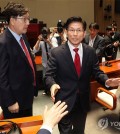- California Assembly OKs highest minimum wage in nation
- S. Korea unveils first graphic cigarette warnings
- US joins with South Korea, Japan in bid to deter North Korea
- LPGA golfer Chun In-gee finally back in action
- S. Korea won’t be top seed in final World Cup qualification round
- US men’s soccer misses 2nd straight Olympics
- US back on track in qualifying with 4-0 win over Guatemala
- High-intensity workout injuries spawn cottage industry
- CDC expands range of Zika mosquitoes into parts of Northeast
- Who knew? ‘The Walking Dead’ is helping families connect
S. Korea not to turn on border propaganda loudspeakers Monday
South Korea’s military has decided not to operate its propaganda loudspeakers near the border with North Korea on Monday, a day after turning them on for the first time in six years in response to the North’s trash-carrying balloon campaign.
The Joint Chiefs of Staff (JCS) announced the move amid questions over the loudspeakers’ possible operation for the second straight day after the North launched some 310 trash-carrying balloons overnight in apparent retaliation against Seoul’s loudspeaker broadcast Sunday.
The JCS had earlier warned that additional broadcasts would depend “entirely” on the North’s actions.
“Loudspeaker broadcasts did not take place as of yet, and none are known to be conducted today,” the JCS said in a statement. “If North Korea conducts despicable acts, (we) are prepared to immediately make the broadcasts.”
The JCS also noted that it detected signs of the North installing loudspeakers of its own near the border, but it has yet to make broadcasts.
The latest batch of waste-loaded balloons sent late Sunday contained scrap paper and plastic, with no toxic material detected so far, according to the JCS. No additional balloons were detected floating in the air as of 8:30 a.m.
JCS spokesperson Col. Lee Sung-jun said many of the balloons failed to reach South Korea due to the wind blowing in an eastward direction, with around 50 balloons being found across the border.
The North did not stage more launches early Monday, but the number of fallen balloons in the South is expected to increase as the military continued to receive reports on them, Lee told reporters in a regular briefing earlier in the day.
Sunday’s launch marked the latest in the North’s balloon campaign that started on May 28, which it described as a “tit-for-tat” response to anti-Pyongyang leafleting by activists in South Korea. The North is estimated to have launched more than 1,600 trash-carrying balloons so far.
Lee said the military did not detect any unusual North Korean military activity after the broadcasts, which lasted for about two hours from 5 p.m. and marked the first since they were halted under an inter-Korean declaration in 2018.
“Considering the strategic and operational situation, (we) will conduct operations flexibly,” Lee said when asked why the military did not resume the broadcasts after the latest balloon launch.
Pyongyang has reacted angrily to the broadcasts in the past, firing artillery shots toward the South in August 2015 over the propaganda loudspeaker campaign.
Late Sunday, Kim Yo-jong, the powerful sister of North Korean leader Kim Jong-un, warned that South Korea will face unspecified “new counteraction” should it continue to send anti-Pyongyang leaflets and play loudspeaker broadcasts across the border.
When asked about the statement, Lee said the North Korean military’s activities are being closely monitored, and that the military will be able to fully respond to what Kim called a “new counteraction.”
“Our military has the capabilities to respond to any North Korean provocation overwhelmingly,” he said.
A military source, however, noted that Kim’s rhetoric appeared to be less threatening than expected.
“At this point … (we) need to watch the situation, remain calm and show restraint,” the source said.
For years, North Korean defectors in the South and conservative activists have sent leaflets to the North via balloons to help encourage North Koreans to eventually rise up against the Pyongyang regime.
North Korea has bristled at the propaganda campaign amid concern that an influx of outside information could pose a threat to its leader Kim Jong-un.
In 2014, the two Koreas exchanged machine-gun fire across the border after the North apparently tried to shoot down balloons carrying propaganda leaflets critical of North Korea.











